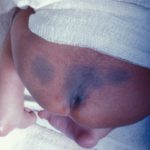- Citas Centro Médico de Caracas: Lunes, Miercoles y Viernes. Pulse el botón Agende una Cita
- Sistema de citas en linea exclusivo para Centro Medico de Caracas en San Bernardino
- Citas CMDLT: Jueves. llamar al 0212-9496243 y 9496245
- Las Emergencias son atendidas en CMDLT previa coordinacion personal al 04142708338
- Proveedor Seguros Mercantil y Sudeban

Changes in skin coloration of the newborn, the appearance of skin lesions and the discovery of some “congenital spots” cause concern in the parents. In this article I present a series of common and not so common conditions for parents, and even some pediatricians, to have at their disposal a small practical guide to recognize and guide the diagnosis of the condition that manifests in the newborn.
(Images by: Am Fam Physician 2008; 77 (1): 47-52.Dermatology advisor)
Skin at birth
The skin of the newborn may be covered by a variable amount of white fat called Unto or Cheesy Vernix and fine body hair. This has nothing to do with maternal diet and is a sign of fetal / neonatal maturity
Miliaria
It is a benign condition due to the obstruction of the sweat glands that appears in up to 40% of babies when “they are very hot” due to weather or excess of clothing, it is eliminated during the first month of life and it is not it requires more treatment than to undress the baby or put it in air conditioning; Sometimes a paste of diluted starch can be placed on the lesions to accelerate the drying of the vesicles. The condition disappears as the skin “matures” and parents learn not to “roast” their baby. This condition is the most frequent of all. The clinical characteristic appearance of multiple vesicles 1-2 mm in the head, face, trunk and neck.
If the vesicles are not red, the picture is called Miliaria Cristalina and if there is a small red area around it, it is called Miliaria Rubra.
Melanocytic nevus
It is an extensive “moon”, usually flat, sometimes thickened, light brown to black that can affect large areas of the baby’s skin. They grow as the baby does and they are of great medical importance because they can cause a cancer known as melanoma (4-6% risk) especially if the lesion is more than 40 cm long or satellite moles in the vicinity of the lesion principal. Requires periodic monitoring
Neonatal toxic erythema
Although the name scares a bit is a benign condition and is not associated with any poisoning; in fact, it is not known what its origin is. The truth is that you can see in 40-70% of mature babies and although they can be born with visible lesions, they usually appear in 2-3 days after birth.
The lesions are small spots or reddish papules of 2-3 mm that can have a point of pus inside, affecting the face, trunk and extremities respecting the palms and the plants. For those who have seen them, they resemble bites by ticks or other insects. Its duration is 5 to 7 days and the baby does not show any other symptoms. It does not require treatment. If the baby looks sick, it must be evaluated for other reasons (fungi, bacteria, viruses)
Seborrheic dermatitis
It is very common and manifests during the first month of life with reddening of the skin and small plaques or oily scabs on the scalp and less frequently on the face, ears and neck. The exact cause is unknown but in some publications the presence of fungi has been determined. It lasts a few weeks or months and finally disappears. The appearance can be frightening but will eventually give way
Since it is a benign self-limiting condition in most cases the treatment is conservative: the head plates can be gently removed while using the shampoo using a soft brush after having placed “petroleum jelly” overnight to soften the plates.
If you do not respond to conservative treatment in a few days to weeks, it is recommended to visit a dermatologist who will initiate more specific treatments.
Cutaneous hemangiomas
The hemangiomas or blood spots are lesions afrested in color and appearance that protrude from the skin of the newborn giving the appearance of an irregular red button. They tend to disappear spontaneously: 50% at 5 years, 70% at 7 and 90% at 10 years. In cases in which the hemangioma persists or its deep location affects important organs or generates aesthetic problems, treatment is indicated by a specialist.
Harlequin Phenomenon, Baby Harlequin
It is an event that could affect up to 10% of newborns and occurs between the second and fifth day of life (2-5 days), I have never seen a case of these but I expose it because if it happened to yours I think that the shock will be huge. In addition, the first thing parents would think is that the obstetrician brutally assaulted the baby.
The truth is that it is a benign and functional condition, probably due to vascular immaturity of the baby that allows irregular vasodilatation of the skin. This phenomenon lasts from 30 seconds to 20 minutes and can manifest itself for about 3 weeks. The episodes last less when the baby has physical activity.
Neonatal acne
Acne of the newborn can occur in up to 20% of cases, is manifested by the presence of comedones (black dots) on the forehead, nose and cheeks. Occasionally you may see inflammatory papules and whiteheads or pustules.
It is believed that it originates by fetal stimulation of male hormones from the maternal circulation, a theory supported by its disappearance in a few months.
Nevus flameus
Stains in Oporto Wine. A flat red to slightly purple spot without tendency to fade over time. They do not require treatment unless they want to be clarified for aesthetic reasons. When they are near the eye, the presence of Glaucoma and an infrequent syndrome called Sturge-Weber Syndrome should be ruled out. If you want to give treatment for aesthetic reasons the best results are obtained before the first year of life (laser therapy)
Marbled skin
This is a transient change in the skin in which the limbs and the trunk acquire a reticulated or marbled appearance. It is due to the cutaneous response to the cold and gives in to shelter the baby.
The tendency to manifest this response to the cold disappears in weeks or months, although in adult life there are people with very white skin that can manifest it regularly.
It is a good sign that would indicate that the baby “has” cold. Does not require treatment
Dermal melanosis
Dermal melanosis is a bluish spot that usually appears on the buttocks or very low back and the perianal region giving the appearance of a bump or bruise in the area. This stain is due to the accumulation of pigment cells in the deep tissues giving the bluish color. It disappears during the first two years of life without leaving any type of sequelae and without requiring any treatment. Asian mythology says that the Mongol stain is because the soul that wanted to enter heaven was kicked in the ass by the Gods, back to earth, to continue reincarnating until ready to stay.
Skin at birth

Miliaria cristalina

Miliaria Rubra

Melanocytic nevus

Toxic erythema
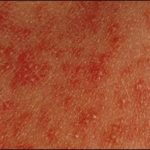
Seborrheic dermatitis

Hemangiomas
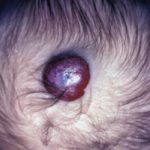
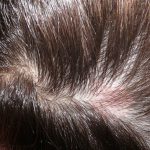
Harlequin phenomenon

Neonatal acne
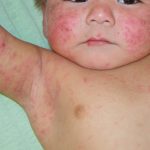
Nevus flameus

Marbled skin
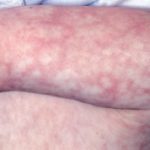
Dermal melanosis
